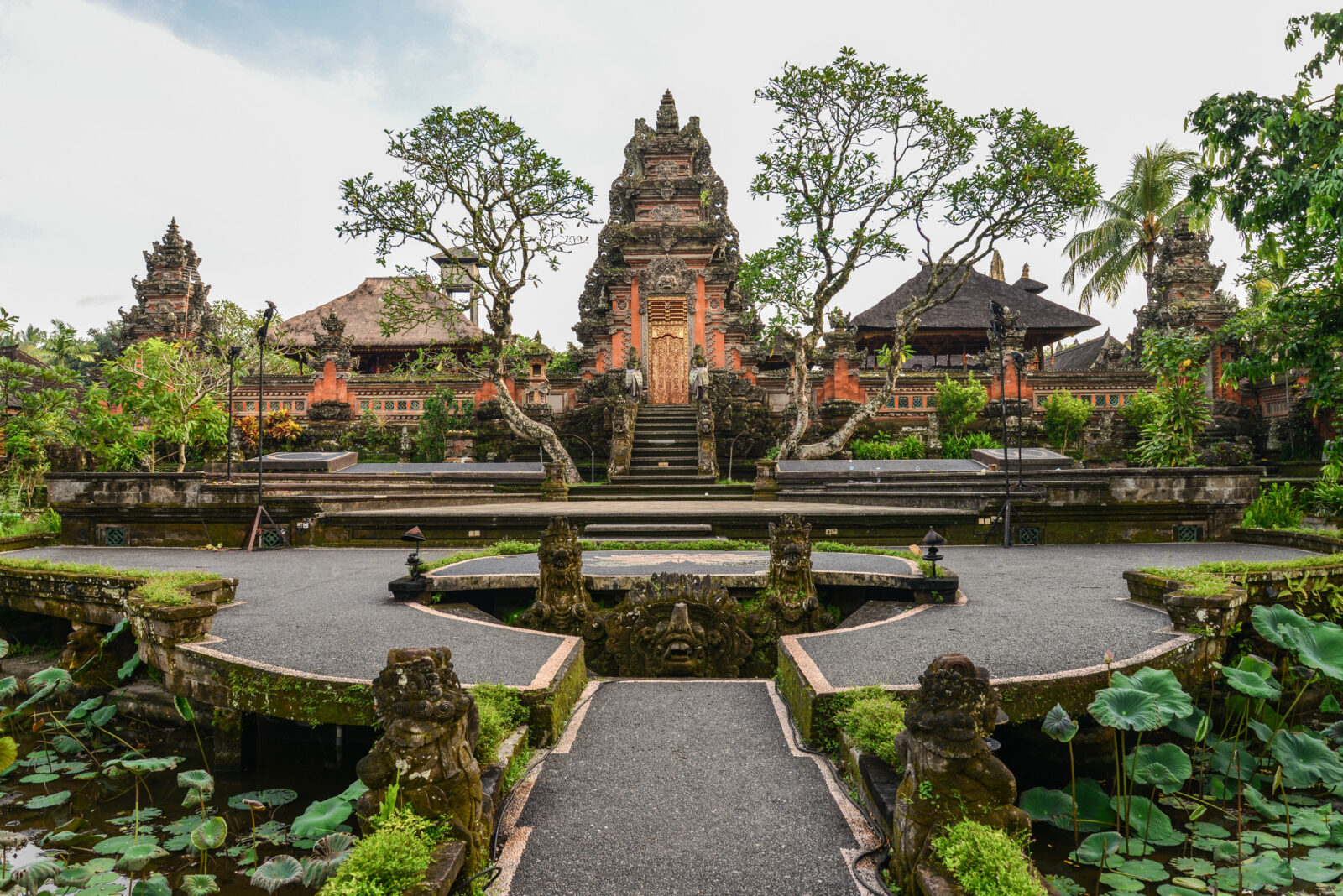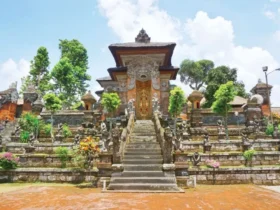Saraswati Temple in Ubud

Nestled in the heart of Ubud, Bali, Saraswati Temple, also known as Pura Taman Saraswati, stands as a remarkable testament to Balinese art, culture, and spirituality. This beautiful temple, dedicated to Dewi Saraswati, the Hindu goddess of knowledge, music, and arts, is a popular attraction for both locals and tourists seeking to experience Bali’s unique blend of art and religious devotion. Here, we’ll explore the history, architectural splendor, cultural significance, and visitor tips for enjoying the wonders of Saraswati Temple in Ubud.
1. The History of Saraswati Temple
Saraswati Temple was built in the 1950s, designed by the celebrated Balinese artist and architect I Gusti Nyoman Lempad. The temple was commissioned by the Ubud royal family, who intended to create a space honoring Dewi Saraswati. This goddess, a revered figure in Hinduism, is often depicted with a veena (a traditional musical instrument), a book, and a rosary, representing wisdom, knowledge, and music. The temple was crafted with elaborate sculptures and intricate carvings, showcasing the depth of Balinese artistic skills.
Lempad’s vision and skill are evident in the intricate reliefs and statues that adorn the temple, telling stories from Balinese mythology and Hindu epics. Since its construction, Saraswati Temple has become a symbol of Ubud’s artistic legacy and spiritual devotion.
2. Temple Architecture and Lotus Pond
The architectural design of Saraswati Temple is nothing short of spectacular. Its main entrance is adorned with traditional Balinese split gates, stone carvings, and statues of Dewi Saraswati. The highlight of the temple, however, is its stunning lotus pond, which greets visitors as they approach the main temple area. The pond is filled with blooming pink and white lotuses, creating a serene and magical atmosphere, especially during sunset when the temple is bathed in soft light. This lotus pond, framed by tropical greenery, has become an iconic feature of Saraswati Temple and a popular photo spot for visitors.
The temple’s layout follows the classic Balinese architectural style, with courtyards that serve specific purposes for different rituals and ceremonies. The carvings on the temple walls depict mythical creatures, gods, and symbols that convey deep spiritual meaning. The gates are often watched over by statues of Hindu gods and deities, symbolizing protection and divine blessing for those who enter.
3. Cultural Significance of Saraswati Temple
Saraswati Temple holds a special place in the hearts of Balinese Hindus as a place to honor Dewi Saraswati, who is believed to bestow wisdom and inspiration. Many local artists, musicians, dancers, and scholars come to the temple to seek her blessings for their creative pursuits. The temple also hosts ceremonies, particularly during Saraswati Day, a Balinese Hindu holiday dedicated to the goddess. On this day, students and artists bring offerings to the temple, and traditional dance performances and rituals take place to celebrate the goddess’s gifts.
For the people of Ubud, Saraswati Temple represents more than just a place of worship—it is a cultural hub that preserves the island’s artistic heritage. The temple’s serene environment inspires creative expression and provides a peaceful sanctuary for contemplation.
4. Traditional Dance Performances
One of the unique aspects of visiting Saraswati Temple is witnessing the traditional Balinese dance performances held in the temple’s courtyard. The performances typically take place in the evening, allowing visitors to enjoy the captivating beauty of Balinese dance against the backdrop of the illuminated temple and lotus pond. Some of the most popular performances include the Legong dance, known for its graceful and expressive movements, and the Barong dance, which depicts a mythological battle between good and evil.
These dance performances are not only entertaining but also a way to experience the cultural richness of Bali. The dancers wear elaborate costumes and intricate headpieces, and their movements are accompanied by the sound of the gamelan, a traditional Balinese musical ensemble. Watching a dance performance at Saraswati Temple is a mesmerizing experience that allows visitors to immerse themselves in Balinese storytelling, art, and spirituality.
5. Spiritual Atmosphere and Temple Etiquette
Saraswati Temple is open to all visitors, but as it is an active place of worship, there are certain customs and etiquettes to be observed. Visitors are required to wear a sarong and sash, which can often be rented or borrowed at the entrance. It’s essential to dress respectfully, covering shoulders and knees, as a sign of respect for the sacredness of the temple grounds.
Inside the temple, it’s important to maintain a quiet demeanor and avoid touching or pointing at the statues and sacred objects. Photography is allowed, but visitors are encouraged to be mindful of ongoing ceremonies and not disrupt the devotees who come to pray. The peaceful ambiance of the temple, combined with its spiritual significance, offers a unique environment for reflection and introspection.
6. Visitor Tips for an Enchanting Experience
Visiting Saraswati Temple can be an unforgettable experience with a few tips to make the most of your time there:
- Best Time to Visit: Early morning or late afternoon are ideal times to visit to enjoy the calm surroundings and avoid the heat. For those interested in traditional dance performances, arrive in the evening, as performances typically start around 7:30 PM.
- Exploring the Grounds: Take your time to stroll around the temple grounds and appreciate the detailed carvings and the tranquil beauty of the lotus pond. The pond is most vibrant when the lotus flowers are in full bloom, usually during Bali’s rainy season from December to February.
- Nearby Attractions: Saraswati Temple is centrally located in Ubud, making it convenient to explore other attractions nearby. Just a short walk away, you’ll find the Ubud Art Market, the Puri Saren Royal Palace, and several local art galleries and cafes.
- Photography Tips: The temple’s lotus pond and traditional gates are incredibly photogenic, especially during golden hour when the lighting enhances the temple’s intricate architecture. Respectfully capture the temple’s beauty while being mindful of worshippers and other visitors.
7. Why Saraswati Temple is a Must-Visit in Ubud
Saraswati Temple stands out among Bali’s temples due to its dedication to the arts and its role in Ubud’s vibrant cultural scene. The temple’s intricate design, peaceful lotus pond, and traditional dance performances make it a unique destination where visitors can connect with Bali’s artistic heritage. For those interested in Balinese culture, Saraswati Temple offers a glimpse into the island’s devotion to preserving its artistic and spiritual roots.
The temple’s serene ambiance and stunning architecture make it a perfect spot for relaxation and contemplation. Whether you’re an art enthusiast, a history lover, or a spiritual seeker, Saraswati Temple provides a rich experience that captures the essence of Balinese culture. This beautiful temple is more than just a tourist attraction—it’s a symbol of the island’s enduring devotion to creativity, knowledge, and inner peace.
8. Practical Information for Visitors
- Location: Saraswati Temple is located on Jalan Kajeng, near Ubud Palace and the Ubud Art Market.
- Opening Hours: The temple is open daily from 7:00 AM to 6:00 PM, while dance performances usually take place around 7:30 PM.
- Entrance Fee: Entrance is typically free, but donations are welcome to help with the temple’s upkeep. Tickets are required for the dance performances and can be purchased on-site.
- Facilities: Sarong rentals are available at the entrance, and several cafes and restaurants nearby offer refreshments and Balinese cuisine.
Saraswati Temple in Ubud is more than just a historic landmark; it is a celebration of Balinese spirituality, art, and cultural heritage. The tranquil lotus pond, the skillfully crafted architecture, and the graceful dance performances offer visitors a well-rounded experience of Bali’s artistic soul. A visit to Saraswati Temple allows you to step into a world where art, religion, and nature harmoniously blend, making it an essential stop for anyone exploring the heart of Bali.










Leave a Review